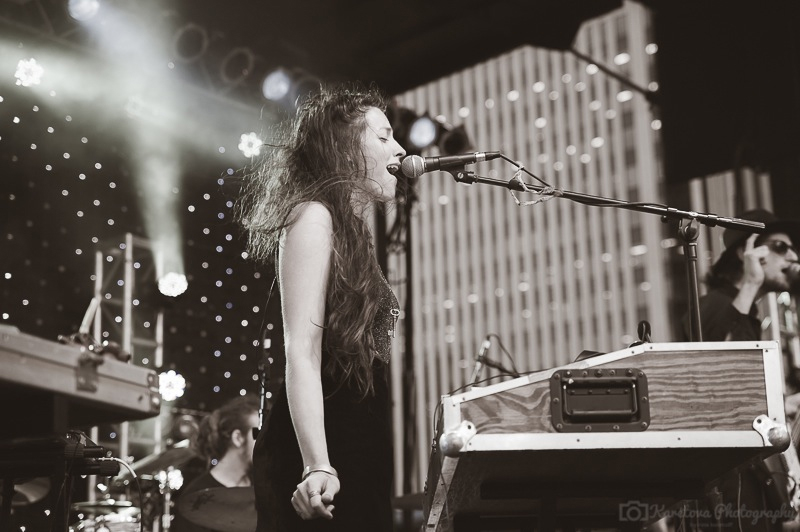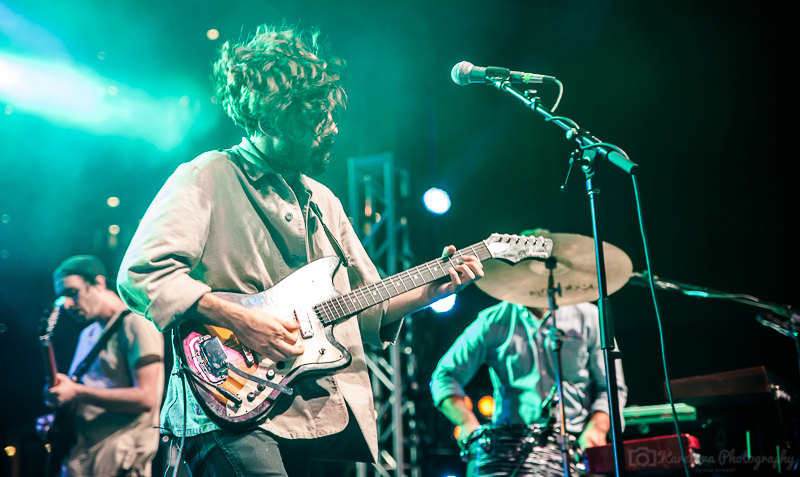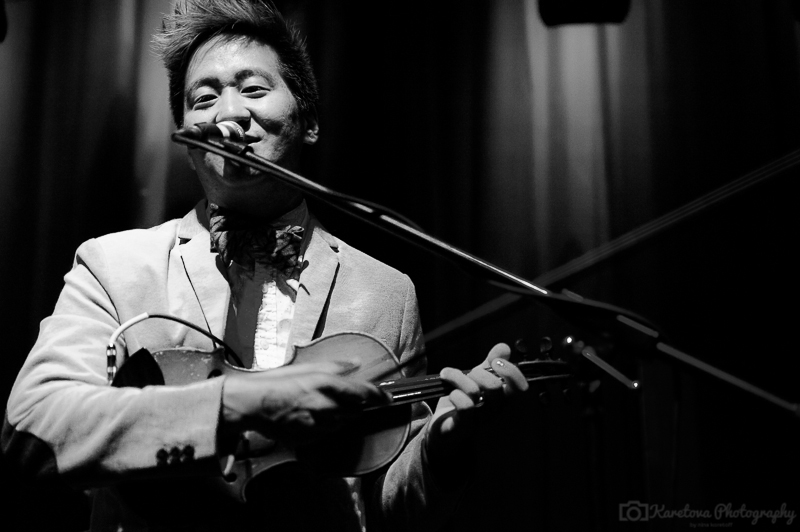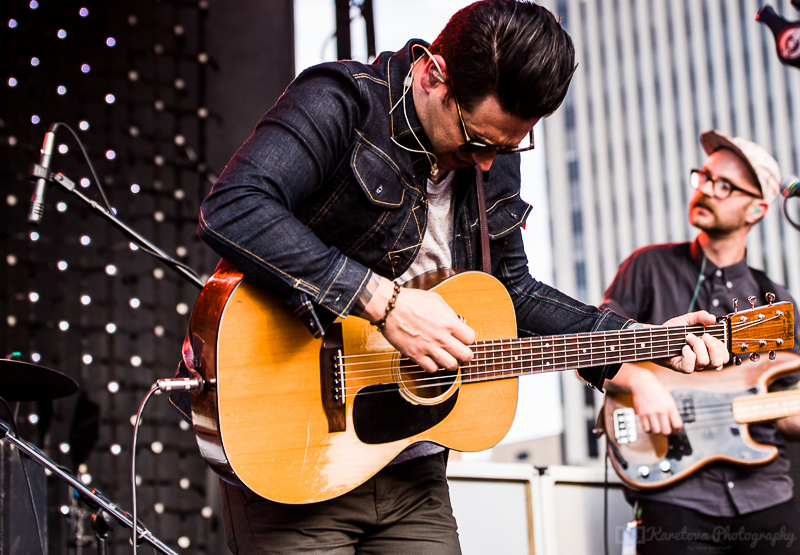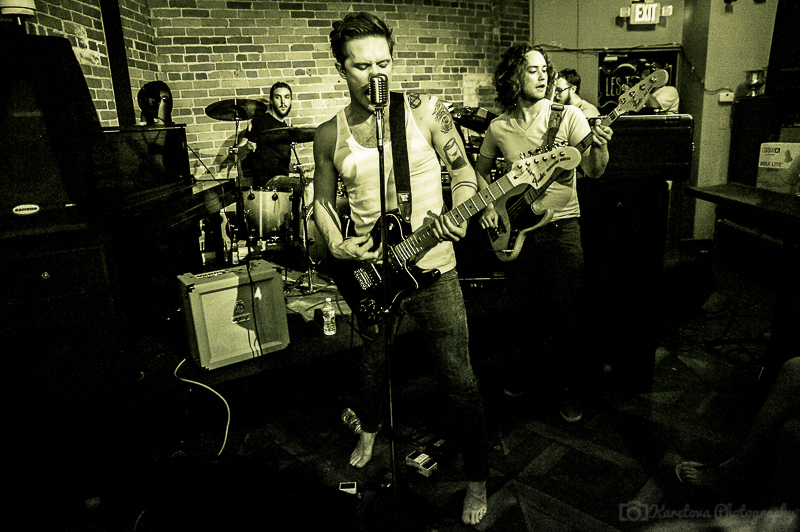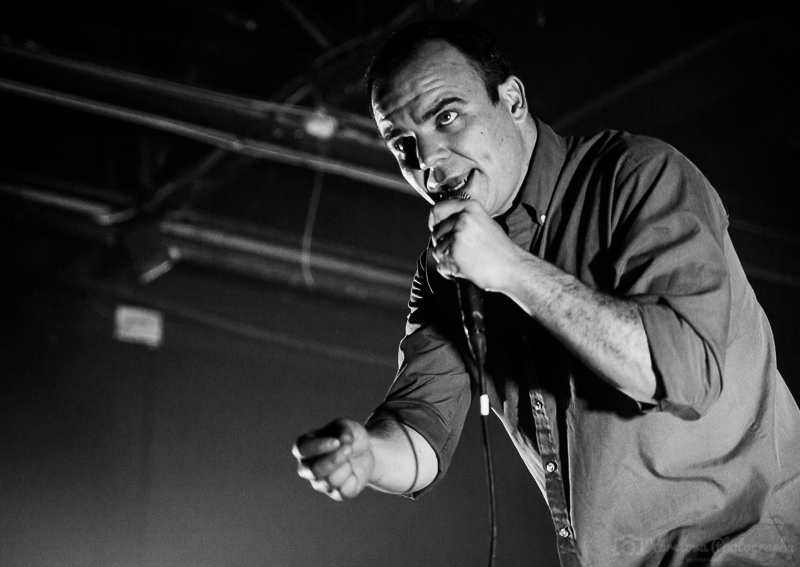
The inaugural Fashion Meets Music Festival came to Columbus, Ohio, Friday to Sunday, August 29th-to-31st:
FRIDAY, AUGUST 29th
Desert Noises
FMMF began with Utah-based rock group Desert Noises performing in front of an undeservedly small crowd at the Cox Stage on Nationwide and High. Despite staring into the setting sun, Desert Noises put on an energetic performance due to their entertaining and endearing camaraderie. The familial vibe of their interactions spilled over into their music making it not just another mix of rock and grunge with a dash of folk stylings. Their sound was driven by a heavy hypnotic bass and kick drum combination, with the skill of the lead guitarist primarily showing during the breakdowns. Their songs would easily have flowed, one into the next, if not broken up by the banter of the bandmates. The group provided a solid opening performance and although the crowd started with only about 20 people, by the end it had at least tripled thanks in large part to the band’s ability to draw in passersby with their sound and style.
Parachute
Parachute followed Michelle Williams on the Stella Artois stage; starting nearly an hour late due to Williams late arrival. The Virginia-based quartet’s sound is reminiscent of ‘90s pop rockers, Train; standard piano chord progressions punctuated with catchy vocals provided by lead singer Will Anderson. More than once Parachute called for audience participation in the form of handclaps and sing-alongs with the ever-present “OooOoohs” that made the songs instantly learnable, yet unengaging to the disinterested crowd. Whether due to the late show time, the charming yet innocuous nature of the songs, or perhaps an ill-timed “fat girl” story, few in the audience participated with enthusiasm.
Bad Veins
Bad Veins provided one of the most surprising and memorable performances of the festival. Listening to the group’s music prior to the show prepared me for the standard indie-pop kitsch that seems to have been mass-produced in some factory over the last five years, but their live performance absolutely destroyed those misconceptions. The stage featured a rose-patterned box with a corded rotary telephone attached to the side and reel-to-reel tape player (affectionately known as ‘Irene’) that provided backing for the guitarist and drummer duo. The backing tunes are a myriad of violins, vocals, and horns but their sounds fall away once Benjamin and Jake start rocking. Jake’s drumming can only be compared to that of Animal from The Muppets—outrageously energetic and equally entertaining. Davis’ guitar is consistent but his face-contorting and impassioned vocals are what really stand out. The rapport between members made it obvious that they enjoy playing together and the crowd responded in kind by singing along to the choruses and clapping when cued. If you have the chance to see Bad Veins live, do yourself a favor and check them out.
Local Natives
The psychedelic indie rock group Local Natives went head-to-head with Columbus darlings O.A.R. for headline bragging rights Friday night. By the time they went on at 9:15 the crowd was so large and raucous that you’d never guess there was another show by a major band being played right around the corner. Harmonies abounded and had an almost ethereal feel, which was amplified when the singing stopped and the guitars took over, introducing repetitive yet not monotonous sounds that seemed to mesmerize the crowd into a swaying mass. Each song ended as though a spell was broken and the crowd showed their approval with plenty of gusto.
O.A.R.
O.A.R. (of a Revolution) was formed in Columbus, Ohio, which gave their set the feel of a group playing for old friends. Having been around since the ‘90s, O.A.R. are obviously old pros at putting on an entertaining performance. Each song seemed to feature a part specifically written for one member who would (instrument portability permitting) jam at the front of the stage, demonstrating their solo skills. The saxophone and guitar solos were especially impressive, each seeming to last minutes at a time, and visibly taxing the men playing. They played songs that spanned their eight studio albums and most had a few dozen to a few hundred people singing along religiously. Judging by the smiles on the faces of the band and the audience it seemed obvious that it was a successful homecoming.
Kishi Bashi
Kishi Bashi put on one of the more memorable shows of the festival. His set at Skully’s Music Diner started humbly, with a simple yet intriguing violin line backed by an equally basic drum beat and bass line, and built to an intricate soundscape in real time. Loop upon loop, measures of deep bass beat boxing followed by some higher pitched vocals created something melodic and mesmerizing. His sound culminated in something organic and complex that you’d expect to be played live by at least a six-member band. Joining him on stage was Tall Tall Trees banjo player Mike Savino. The banjo added to Bashi’s high-paced, complicated sound. The audiences’ attention was drawn back and forth, from one performer to another. The combination of building violin and vocal loops with the fast-paced banjo sounded like what you would expect if Dan Deacon teamed up with Bela Fleck. For those that have never seen Savino play his green-and-red LED filled banjo, he not only deftly moves around the fretboard while strumming and plucking at an absurd pace but also uses a mallet and his hands to make percussive bongo-like sounds that adds a not often heard complexity in the folk world. Over the hour, Bashi led Savino and others in a variety of originals like fan favorite “The Ballad of Mr. Steak”, as well as notable covers including Paul McCartney’s “Live and Let Die” with a Red Hot Chili Peppers bassline that was weird but worked. The mashup was truly an engaging metaphor for the eclectic patchwork of band members and was a further tribute to an overall crowd-pleasing performance.
SATURDAY, AUGUST 30th
The Future Laureates
The Future Laureates were one of many indie/rock/folk bands at Fashion Meets Music, which often makes it hard to differentiate between the various acts after seeing so many. The Laureates uniqueness came first at face value, featuring a ukulele in every song. Despite the typically pigeonholed instrument’s presence, the band had a more hard rock feel rather than the folk or island music you might expect, and was even featured as the lead in their own version of a blues song. The lead electric guitarist with his snazzy green Rickenbacker was a particular favorite of mine, cleanly pulling off lick after lick with total nonchalance. The band has a very down-to-earth vibe that was evident when we sat down to talk with them after their show.
Twin Forks
The Floridian five-piece, Twin Forks performed Saturday led by Dashboard Confessional frontman Chris Carrabba. Carrabba and company presented a folk style heard through much of the festival with the notable addition of a mandolin player. Their music had the feel of a campfire sing-along; very basic drums and acoustic guitar with catchy two- and three-part harmonies. Aside from an accidental chain of expletives and quick apology, Carrabba engaged the crowd with his between song discussions and Johnny Cash-esque stage persona.
E.O.P.
The Evan Oberland Project, better known as E.O.P., was a major standout of the festival and definitely in the top three shows of the entire weekend. Their style crossed genres – jazz-fusion mixed with rock and hip-hop and a dash of soul. It was like hearing Karl Denson’s Tiny Universe play with Yasin Bey (formerly Mos Def) at his best. The group featured a tremendously talented trombonist and trumpeter, each of whom exhibited their skills in elaborate solos. The sound was a refreshing one in a festival full of nigh-indistinguishable folk acts and I would venture that many people agreed with that opinion as the crowd went from around 30 people at the start to a couple hundred by the finish. After the show the lead singer had a few minutes to talk with us about the group.
Switchfoot
Saturday ended with headliners Switchfoot playing at the Stella Artois stage overlooking a vast grassy field of fans. Switchfoot are Christian rockers with broad appeal, thanks in large part to their excellent audience interaction. The guitarists and lead singer frequently leaned down into the press pit, posing for the cameras and putting on a theatrical performance. By the end of the first song, frontman Jon Foreman was already in the middle of the crowd with mic in hand, high-fiving fans and organically prompting their involvement in the show. The group’s alternative rock sound betrayed their ‘90s origins, and while it was largely appreciated the sincere love for their fans is what left the biggest impression.
SUNDAY, AUGUST 31st
Cold War Kids
Cold War Kids headlined on the Stella stage Sunday night. Their set started with the broad appeal of simple piano riffs and vocal harmonies. While the sound induced some head nodding and foot tapping, the crowd really got into the show when the second song started, cheering instantly and singing along with the chorus. Many of the songs from then out were bass-driven and featured heavy synth and by the third song fans were clapping along without cue. Unfortunately, the lighting on stage came almost entirely from behind the band, making the members bland silhouettes instead of three-dimensional artists. This made the entire show dependent on the music and luckily it was performed well enough to merit the band’s popularity.
Plaid Brixx
Plaid Brixx is the brainchild of Chris Duggan, a man with a passion for his music and a singularity of focus not often found in men his age. We had a chance to talk with Chris about his band, newly released album, and upcoming tour schedule early Saturday. The evening show started half an hour late due to a miscommunication that seemed to plague many parts of the festival. There was no P.A. system so they grabbed the equipment from their practice space and frantically set it up in the small café space. Once they started, their hard rock sound had the soul of a much more mature group. Frenetic guitar riffs and angry drums defined their sound with the occasional solo. The vocals were difficult to decipher due to the impromptu setup, but the small crowd forgave the errors that clearly were not the band’s fault.
Future Islands
Future Islands played at midnight at the Saloon on Park Street. The group pulled a headliner-size crowd and for good reason. Future Islands’ sound is reminiscent of any ‘80s dystopian flick, featuring driving synth and bass that was downright hypnotic. The songs were accompanied by pulsing lights that matched the deeply penetrating feel of the music. Singer Samuel Herring gave the best performance of the group, with furrowed eyebrows and frequent fist pumps that were probably closer to shadow boxing than anything. The other members provided plenty of contrast – while they hit all the right notes they played as though they were mindless zombies, perhaps mesmerized by their own music. The set list progressed with up-tempo songs appearing later, driving the audience into a jumping mass that delivered more and more applause with each break. In person, Future Islands sounded just like their albums and that combined with clever presentation made for a great show.
Fever Fever
Fever Fever played an after-hours event at the Three Legged Mare on the last day of the festival. The group makes music that is absolutely impossible to hate but also difficult to love. Their indie folk sound is pleasant despite featuring numerous clichés and has a familiar feel even if you’ve never heard them before. The lyrics are generic – “I’ve never felt this way” (what way?) and they employ numerous musical tropes including the “clap-clap-clap” and “oooohs” that make every listener feel like they know the song by the second verse. It is the kind of music that would be good to work to because it’s not distracting or the perfect soundtrack for a pleasant summer day. In fact, the group credits nature as a primary source of inspiration and discussed their formation and creative process in an interview with us earlier in the day.
FMMF Afterthoughts
Fashion Meets Music had many of the hallmarks of a first year event: lots of ambition but also lots of room for improvement. The most noticeable flaw was the crowd size – every day began with shows that had only a handful of attendees. We talked to a number of people around Columbus and found two primary reasons for the poor attendance: they either did not know the event was taking place or they thought the free event required paying for tickets. Clarity and advertising will require significant improvement in future iterations. Many events were not located where or when the official program listed them, likely due to the numerous lineup changes prior to the start. Fashion rarely met music. Designers were sequestered in the convention center or movie theater (a suboptimal runway location) whereas the music almost all took place outdoors on one of three stages. The festival had its positive points. The bands mostly put on great shows, which is what matters the most. The event staff were very positive and helpful, especially Big Picture Media, who communicated with us throughout the festival to make all of our interviews possible, but if it’s going to make it to a second year or beyond there are going to have to be a number of behind-the-scenes changes.







